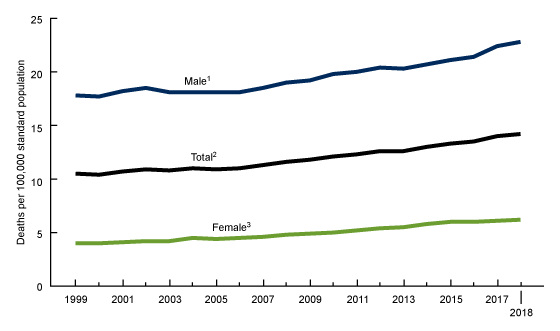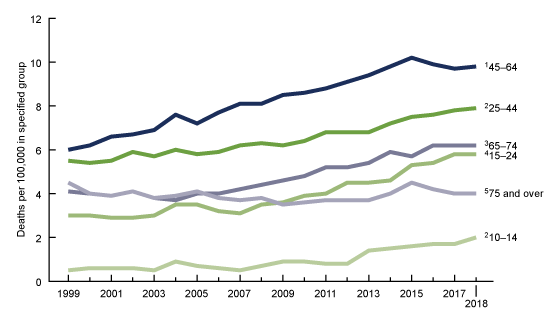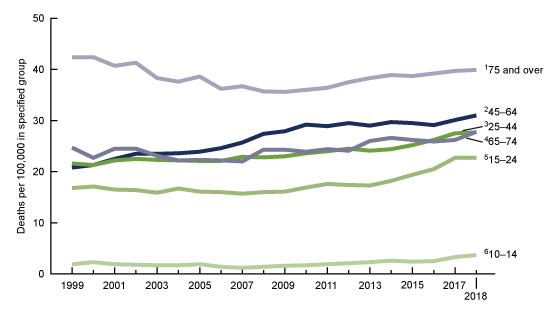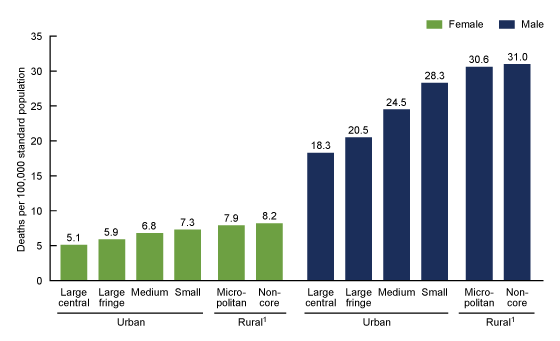Increase in Suicide Mortality in the United States, 1999–2018
- Key findings
- From 1999 through 2018, suicide rates increased for both males and females, with greater increases occurring after 2006.
- Among females, suicide rates were highest for those aged 45–64 and lowest for those aged 10–14 from 1999 through 2018.
- Among males, suicide rates were highest for those aged 75 and over and lowest for those aged 10–14 from 1999 through 2018.
- For both males and females, suicide rates in 2018 were higher in rural than in urban counties.
- Summary
- Data source and methods
- About the authors
- References
- Suggested citation
PDF Version (480 KB)
Holly Hedegaard, M.D., Sally C. Curtin, M.A., and Margaret Warner, Ph.D.
Key findings
Data from the National Vital Statistics System, Mortality
- From 1999 through 2018, the suicide rate increased 35%, from 10.5 per 100,000 to 14.2.
- The rate increased on average approximately 1% per year from 1999 to 2006 and by 2% per year from 2006 through 2018.
- In 2018, the suicide rate for males was 3.7 times the rate for females (22.8 and 6.2, respectively).
- From 1999 through 2018, suicide rates among females were highest for those aged 45–64; among males, the rates were highest for those aged 75 and over.
- In 2018, suicide rates were higher in the most rural counties compared with the most urban counties for both males and females.
Suicide is the 10th leading cause of death for all ages in the United States (1). Suicide is a major contributor to premature mortality as it ranks as the second leading cause of death for ages 10–34 and the fourth leading cause for ages 35–54 (1). Despite national goals to lower the suicide rate (2), several recent reports have documented a steady increase in suicide rates in recent years (3–6). This data brief uses final mortality data from the National Vital Statistics System (NVSS) to update trends in suicide rates from 1999 through 2018 and to describe differences by sex, age group, and urbanicity of county of residence.
Keywords: underlying cause of death, intentional self-harm, urban-rural, National Vital Statistics System
From 1999 through 2018, suicide rates increased for both males and females, with greater increases occurring after 2006.
- From 1999 through 2018, the age-adjusted suicide rate increased 35%, from 10.5 per 100,000 U.S. standard population to 14.2 (Figure 1). The rate increased on average by about 0.8% per year from 1999 to 2006 and by 2.1% per year from 2006 through 2018.
- Suicide rates for males were 3.5 to 4.5 times the rate for females over the entire time period.
- For males, the rate increased 28% from 17.8 in 1999 to 22.8 in 2018. After a stable trend from 1999 to 2006, the rate increased on average by about 1.6% per year from 2006 to 2016 and by 3.2% per year from 2016 through 2018.
- For females, the rate increased 55%, from 4.0 in 1999 to 6.2 in 2018. The rate increased on average by about 1.9% per year from 1999 to 2007 and by 3.3% per year from 2007 to 2015, then did not change significantly from 2015 through 2018.
Figure 1. Age-adjusted suicide rates, by sex: United States, 1999–2018
1Stable trend from 1999 to 2006; significant increasing trend from 2006 through 2018 with different rates of change overtime, p < 0.05.
2Significant increasing trend from 1999 through 2018 with different rates of change over time, p < 0.05.
3Significant increasing trend from 1999 to 2015 with different rates of change over time; stable trend from 2015 through 2018, p < 0.05.
NOTES: Suicides are identified using International Classification of Diseases, 10th Revision underlying cause-of-death codes U03, X60–X84, and Y87.0. Age-adjusted death rates were calculated using the direct method and the 2000 U.S. standard population. Access data table for Figure 1.
SOURCE: NCHS, National Vital Statistics System, Mortality (NVSS-M).
Among females, suicide rates were highest for those aged 45–64 and lowest for those aged 10–14 from 1999 through 2018.
- Suicide rates among females generally increased between 1999 and 2018 for all age groups, except women aged 75 and over, although patterns of increase varied by age with different rates of change over time (Figure 2).
- Suicide rates were highest among females aged 45–64, increasing from 6.0 per 100,000 in 1999 to 10.2 in 2015. Rates decreased slightly to 9.8 in 2018, but this decline was not statistically significant.
- Suicide rates were lowest among females aged 10–14. The rate for this age group increased from 0.5 in 1999 to 2.0 in 2018.
Figure 2. Suicide rates for females, by age group: United States, 1999–2018
1Significant increasing trend from 1999 to 2015; stable trend from 2015 through 2018, p < 0.05.
2Significant increasing trend from 1999 through 2018, with different rates of change over time, p < 0.05.
3Stable trend from 1999 to 2004; significant increasing trend from 2004 to 2016; stable trend from 2016 through 2018,
p < 0.05.
4Stable trend from 1999 to 2007; significant increasing trend from 2007 through 2018, p < 0.05.
5Significant decreasing trend from 1999 to 2012; stable trend from 2012 through 2018, p < 0.05.
NOTES: Suicides are identified using International Classification of Diseases, 10th Revision underlying cause-of-death codes U03, X60–X84, and Y87.0. Access data table for Figure 2.
SOURCE: NCHS, National Vital Statistics System, Mortality (NVSS-M).
Among males, suicide rates were highest for those aged 75 and over and lowest for those aged 10–14 from 1999 through 2018.
- Among males under age 75, suicide rates generally increased over the period (Figure 3).
- Suicide rates among males were highest for those aged 75 and over, decreasing from 42.4 per 100,000 in 1999 to 35.6 in 2009, then increasing to 39.9 in 2018.
- Suicide rates among males were lowest for those aged 10–14, decreasing from 1.9 in 1999 to 1.2 in 2007 and then increasing to 3.7 in 2018.
Figure 3. Suicide rates for males, by age group: United States, 1999–2018
1Significant decreasing trend from 1999 to 2008, then increasing trend from 2008 through 2018, p < 0.05.
2Significant increasing trend from 1999 to 2010 with different rates of change over time; stable trend from 2010 through 2018, p < 0.05.
3Significant increasing trend from 1999 through 2018, with different rates of change over time, p < 0.05.
4Stable trend from 1999 to 2005; significant increasing trend from 2005 through 2018, p < 0.05.
5Significant decreasing trend from 1999 to 2007, then increasing trend from 2007 through 2018 with different rates of change over time, p < 0.05.
6Significant decreasing trend from 1999 to 2008, then increasing trend from 2008 through 2018, p < 0.05.
NOTES: Suicides are identified using International Classification of Diseases, 10th Revision underlying cause-of-death codes U03, X60–X84, and Y87.0. Access data table for Figure 3.
SOURCE: NCHS, National Vital Statistics System, Mortality (NVSS-M).
For both males and females, suicide rates in 2018 were higher in rural than in urban counties.
- In 2018, suicide rates for females ranged from 5.1 in the most urban counties (large central) to 8.2 in the most rural counties (noncore). For males, the rates ranged from 18.3 to 31.0 (Figure 4).
- For both males and females, rates were higher in rural counties than in urban counties.
- For all levels of urbanicity, suicide rates for males were 3.5–3.9 times the rate for females.
Figure 4. Age-adjusted suicide rates, by sex and urbanicity of county of residence: United States, 2018
1Rates for rural county groups are higher than for urban county groups, p < 0.05.
NOTES: Suicides are identified using International Classification of Diseases, 10th Revision underlying cause-of-death codes U03, X60–X84, and Y87.0. Age-adjusted death rates were calculated using the direct method and the 2000 U.S. standard population. Counties were classified using the 2013 National Center for Health Statistics Urban–Rural Classification Scheme for Counties available from: https://www.cdc.gov/nchs/data/series/sr_02/sr02_166.pdf. Access data table for Figure 4.
SOURCE: NCHS, National Vital Statistics System, Mortality (NVSS-M).
Summary
This report highlights trends in suicide rates from 1999 through 2018. During this period, the age-adjusted suicide rate increased 35%, from 10.5 per 100,000 U.S. standard population in 1999 to 14.2 in 2018. The average annual percentage increase in the national suicide rate increased from approximately 1% per year from 1999 to 2006 to 2% per year from 2006 through 2018. The age-adjusted suicide rate among females increased 55%, from 4.0 in 1999 to 6.2 in 2018, while the rate for males increased 28%, from 17.8 to 22.8. Suicide rates were consistently higher for males compared with females over the entire time period.
Suicide rates in 2018 were higher than in 1999 for males and females in all age groups under age 75. Among females, suicide rates from 1999 through 2018 were highest for those aged 45–64 and lowest for those aged 10–14. Among males, suicide rates were highest for those aged 75 and over and lowest for those aged 10–14. After years of increase, the suicide rates for several demographic groups have stabilized in recent years. These include females aged 45–64, 65–74, and 75 and over, and males aged 45–64. Females aged 10–44, males aged 10–44, and males 65 and over continue to experience increasing trends in suicide rates.
In 2018, the suicide rate for females in the most rural counties (noncore) was 1.6 times the rate in the most urban counties (large central), 8.2 and 5.1 per 100,000, respectively. A similar pattern was seen for males where the suicide rate in the most rural counties (31.0) was 1.7 times the rate in the most urban counties (18.3). For all levels of urbanicity, suicide rates were higher for males than for females.
Data source and methods
Data were analyzed using the NVSS multiple cause-of-death mortality files for 1999 through 2018 (7). Suicide deaths were identified using International Classification of Diseases, 10th Revision (ICD–10) underlying cause-of-death codes U03, X60–X84, and Y87.0 (8). Age-adjusted death rates were calculated using the direct method and the 2000 U.S. standard population (9). Suicides for persons aged 5–9 years were included in the total numbers and age-adjusted rates, but are not shown as part of age-specific numbers or rates due to the small number of suicides per year among this age group.
Urbanization level of the decedent’s county of residence was categorized using the 2013 National Center for Health Statistics Urban–Rural Classification Scheme for Counties (10). In this scheme, counties are classified into six urbanization levels based primarily on metropolitan–nonmetropolitan status and population distribution. Metropolitan counties include large central counties, the fringes of large counties (suburbs), medium counties, and small counties. Nonmetropolitan counties include micropolitan statistical areas and noncore areas, including open countryside, rural towns (populations of less than 2,500), and areas with populations of 2,500–49,999 that are not part of larger labor market areas.
Trends in age-adjusted death rates were evaluated using the Joinpoint Regression Program (4.7.0.0) (11). The Joinpoint software was used to fit weighted least-squares regression models to the estimated proportions on the logarithmic scale. Using the default settings, which allowed for as few as two observed time points in the beginning, ending, and middle line segments (excluding the joinpoints), a maximum of three joinpoints were searched for using the Grid search algorithm and the permutation test and an overall alpha level of 0.05 (12). Pairwise comparisons of rates in Figure 4 were conducted using the z test with an alpha level of 0.05 (9).
About the authors
Holly Hedegaard is with the National Center for Health Statistics (NCHS), Division of Analysis and Epidemiology and Sally C. Curtin and Margaret Warner are with NCHS, Division of Vital Statistics.
References
- CDC WISQARS. Ten leading causes of death by age group.
- U.S. Department of Health and Human Services. Healthy People 2020. Mental health and mental disorders objectives. 2010.
- Hedegaard H, Curtin SC, Warner M. Suicide mortality in the United States, 1999–2017. NCHS Data Brief, no 330. Hyattsville, MD: National Center for Health Statistics. 2018.
- Hedegaard H, Curtin SC, Warner M. Suicide rates in the United States continue to increase. NCHS Data Brief, no 309. Hyattsville, MD: National Center for Health Statistics. 2018.
- Stone DM, Simon TR, Fowler KA, Kegler SR, Yuan K, Holland KM, et al. Vital Signs: Trends in state suicide rates—United States, 1999–2016 and circumstances contributing to suicide—27 states, 2015. MMWR Morb Mortal Wkly Rep 67(22):617–24. 2018.
- Curtin SC, Warner M, Hedegaard H. Increase in suicide in the United States, 1999–2014. NCHS Data Brief, no 241. Hyattsville, MD: National Center for Health Statistics. 2016.
- National Center for Health Statistics. Public-use data files: Mortality multiple cause files. 2018.
- World Health Organization. International statistical classification of diseases and related health problems, 10th revision (ICD–10). 2008 ed. Geneva, Switzerland. 2009.
- Kochanek KD, Murphy SL, Xu JQ, Arias E. Deaths: Final data for 2017. National Vital Statistics Reports; vol 68 no 9. Hyattsville, MD: National Center for Health Statistics. 2019.
- Ingram DD, Franco SJ. 2013 NCHS Urban–rural classification scheme for counties. National Center for Health Statistics. Vital Health Stat 2(166). 2014.
- National Cancer Institute. Joinpoint Regression Program (Version 4.7.0.0) [computer software]. 2019.
- Ingram DD, Malec DJ, Makuc DM, Kruszon-Moran D, Gindi RM, Albert M, et al. National Center for Health Statistics Guidelines for Analysis of Trends. National Center for Health Statistics. Vital Health Stat 2(179). 2018.
Suggested citation
Hedegaard H, Curtin SC, Warner M. Increase in suicide mortality in the United States, 1999–2018. NCHS Data Brief, no 362. Hyattsville, MD: National Center for Health Statistics. 2020.
Copyright information
All material appearing in this report is in the public domain and may be reproduced or copied without permission; citation as to source, however, is appreciated.
National Center for Health Statistics
Jennifer H. Madans, Ph.D., Acting Director
Amy M. Branum, Ph.D., Acting Associate Director for Science
Division of Analysis and Epidemiology
Irma E. Arispe, Ph.D., Director
Kevin C. Heslin, Ph.D., Associate Director for Science
Division of Vital Statistics
Steven Schwartz, Ph.D., Director
Isabelle Horon, Dr.P.H. Acting Associate Director for Science



